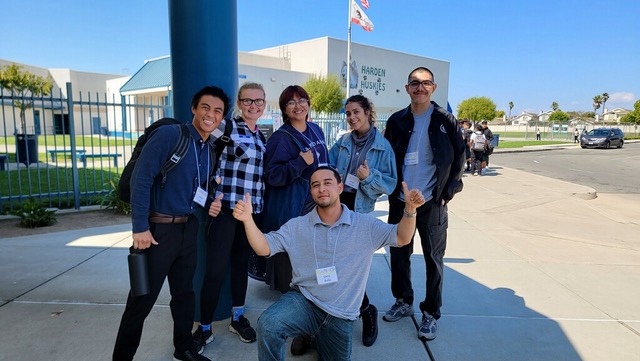Campus News
UC Santa Cruz Cal Teach program connects area STEM majors with local public schools
Established in fall 2005, the UCSC Cal Teach program is one of nine in the UC system, with a goal to recruit and support undergrads in the STEM field to become teachers in K-12 schools.

As schools nationwide aim to address prevalent teacher shortages, one long-standing UC Santa Cruz program aims to find solutions to that issue head-on.
Established in fall 2005, the UC Santa Cruz Cal Teach program is one of nine in the UC system, with a goal to recruit and support undergrads in the STEM field to become teachers in K-12 schools. The program’s first cohort began working with local area high school and middle school classes in spring 2006.
In the time since, 1,200 students have taken Cal Teach courses at UC Santa Cruz. Currently, the program works with between 55 and 70 student first-time participants per year.
Director Gretchen Andreasen — who’s been with the program since its inception — said that the program was launched at the time because of the chronic shortage of math and science teachers both across the state and the country. With the giant proportion of math, science and engineering majors graduating throughout California, Cal Teach was meant as a directive, to help offset the shortage with those recent graduates who may be interested in K-12 education.
“It gave many more STEM majors an opportunity to consider teaching at an earlier stage in their career,” she said.
The program was a successor to a pre-existing UC Santa Cruz program called CMS-T, which served approximately 15 students per year, mostly in their junior and senior years. With Cal Teach, Andreasen works with students across grade levels, where students can start a sequence of courses and internships beginning in their freshman year, with one course per year until graduation.
“We’re teaching [our] students about teaching and learning and learning theory, as well as professional development,” Andreasen said.
Each Cal Teach participant has an individual internship classroom placement in a local middle school or high school. Carmen Garcia Ramirez is one such student, currently in her junior year at UC Santa Cruz studying biology. During the fall quarter, Ramirez interned at E.A. Hall Middle School, where she partnered with a Cal Teach graduate, Roberto Martinez.
While it was exciting for the two to work together this past quarter, both also share additional Cal Teach experience: having learned from previous Cal Teach participants while at Aptos High School and Harbor High School.
For Ramirez, her Cal Teach teacher at Aptos High School was unlike any of the “traditional textbook” teachers she had prior — and that further inspired her to join the program when she was a sophomore at UC Santa Cruz.
“The way that she ran the class was such a beneficial experience for me as a student — I feel like I learned a lot in that classroom,” she said. “And it actually only boosted my dream of being a teacher one day.”
Martinez said that his previous work with Cal Teach at Harbor High School “didn’t click” until he arrived at UC Santa Cruz and began the Cal Teach program himself. As he progressed through the program for 2.5 years, he shadowed at both Soquel High School and Pajaro Valley High School; he was able to connect with his students, which helped him to better prepare for his full-time role at E.A. Hall Middle School.
“These students, they’re willing to talk to you if you treat them as people,” he said. “If you treat them as kind of pretty much equal, they are willing to share part of their lives with you — if you can make those small connections, they feel more connected to you, and you can become part of that community.”
Now in her second year with the program, Ramirez said that Cal Teach is not only a helpful tool but an incredible support system for soon-to-be teachers like herself.
“I think that the opportunity that we have as students to intern in a classroom is where we really get to see [the information] play out,” she said. “Cal Teach, they’re like the backbone, and they’re just supporting you the whole way through.”
Looking forward, Andreasen said that the program has more students now compared to the 2021 school year. While there has been some worry about teacher shortages negatively impacting enrollment, that’s not what Andreasen is seeing with Cal Teach.
“Students are really engaged right now, which is nice,” she said. “I think that, by providing the opportunity for students to be in the classroom in a teacher role as an undergraduate, we open the minds of many students to teaching who wouldn’t have otherwise seriously considered it…that’s just as important now as it was at the beginning.”